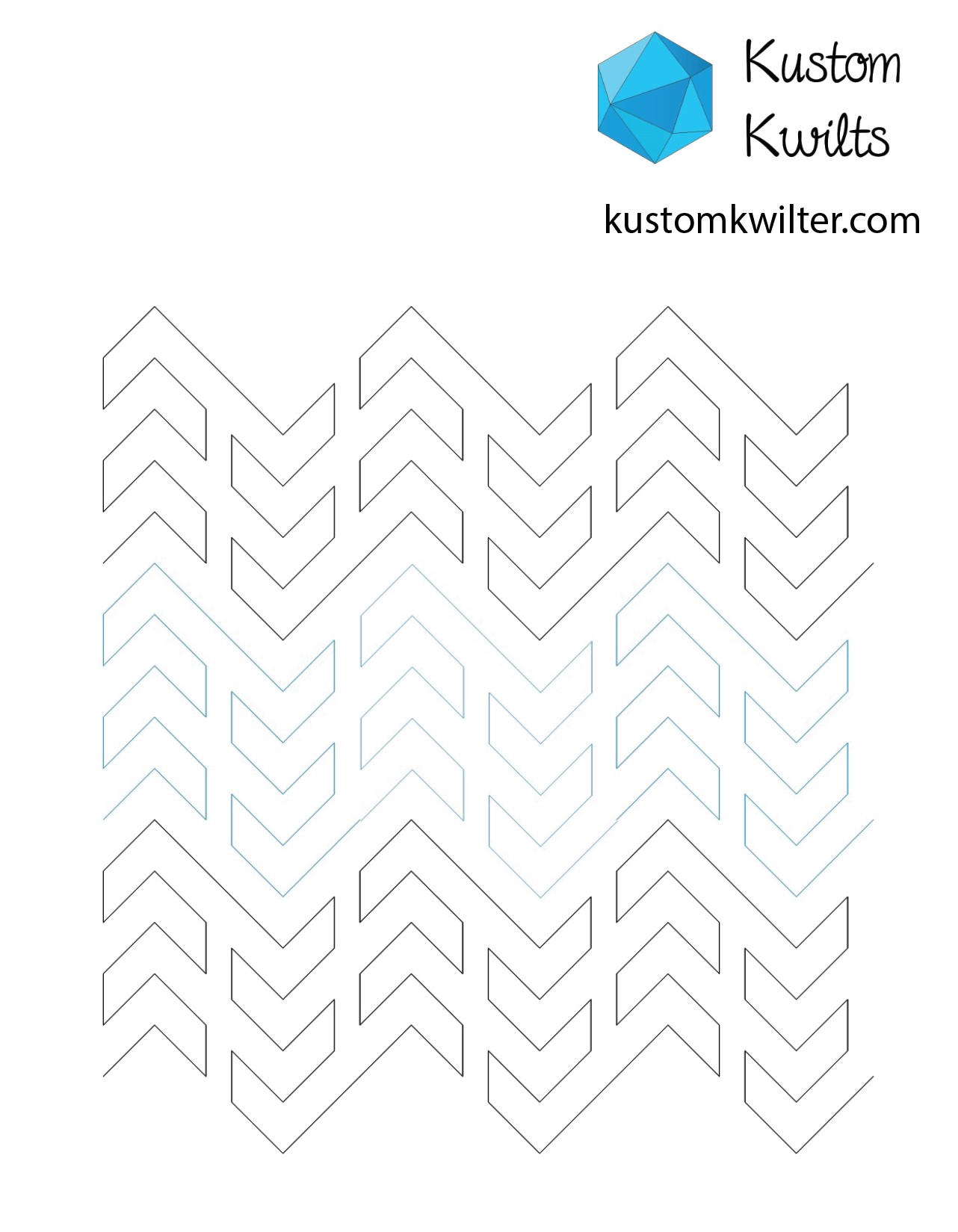

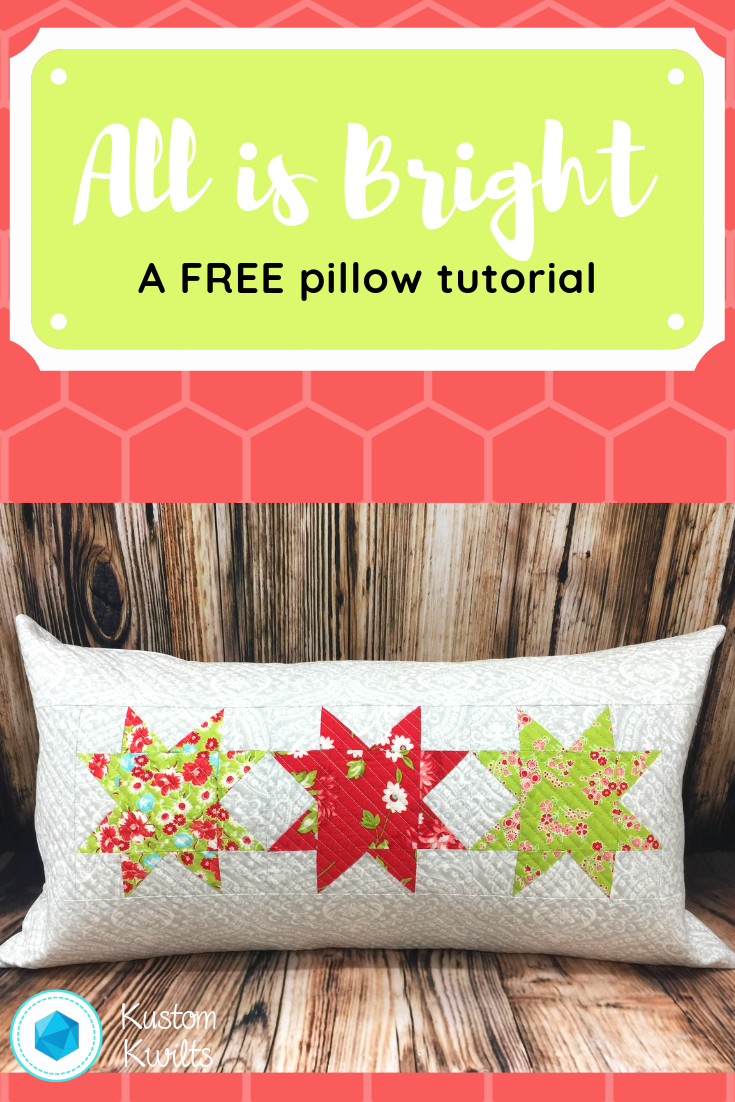
Are you tired of your throw pillows and need a quick way to freshen up your home dec? Grab a few sewing supplies, a pillow form, and some fabric and you’ll be on your way to piecing and quilting up this simple pillow cover in no time at all! I made my pillow on the Janome MC9400, but it can easily be adapted to work with any sewing machine and it’s helpful if you’ve got a walking foot (or some sort of dual feed device), but not a deal breaker! This tutorial consists of piecing some flying geese units and doing a little straight line quilting to add a modern punch to your home dec. Check out the supply list below, then click on the PDF instructions “All is Bright” below for the complete project.

I can’t wait to see how your pillow turns out! I hope you’ll tag me on Instagram @kustomkwilts when you finish your awesome project 🙂
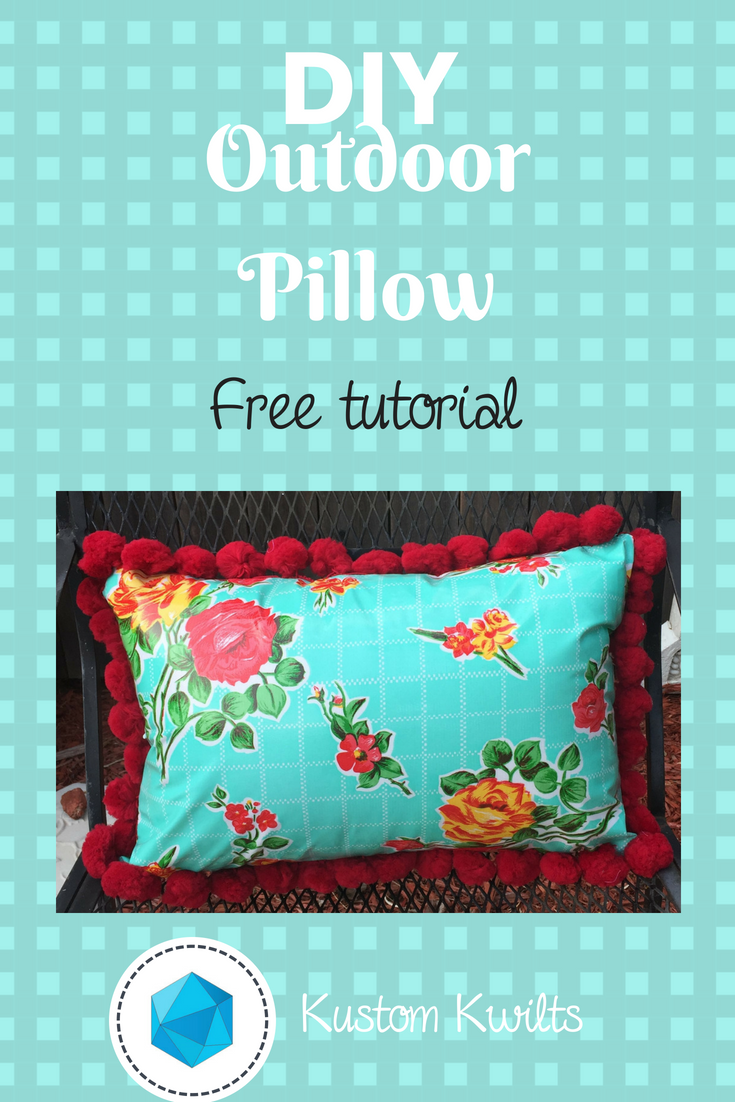
DIY Outdoor Pillow tutorial
Are you looking for a way to brighten up your patio with some fun home dec pillows? Make your own DIY outdoor pillow with this quick and easy tutorial to create a super cute oilcloth pillow with pom pom trim, and give your deck a cheery look! I used my Janome Horizon Memory Craft 9400QCP and the Janome Ultra Glide Needle Plate and Ultra Glide Foot to stitch up this oilcloth pillow. Start sewing with some new fabrics and try out a new foot attachment that will take your sewing projects to the next level. The Ultra Glide Needle Plate and Ultra Glide Foot set is perfect for working with fabrics that might not smoothly feed under the standard foot A, such as oilcloth and laminated cotton. Also, check out my previous post on TOP TIPS FOR SEWING WITH OILCLOTH. This is a great tutorial for beginners, and will take approximately 4 hours from start to finish. The finished pillow size is 12″ x 18″.
Supplies: Sewing machine, Janome Ultra-Glide foot and Ultra Glide Needle Plate (Teflon foot for all other sewing machine brands), Zipper foot (Foot E for Janome), Needle, Pre-wound bobbin.
Fabric/notions required:
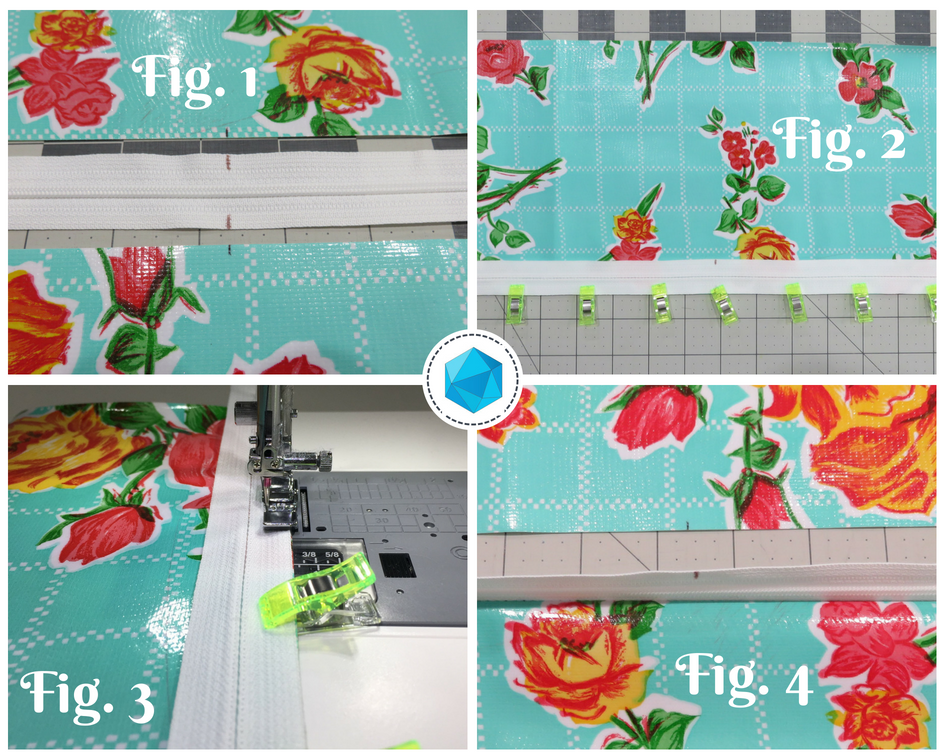
Prepare the back of the pillow and install the zipper
Tip: Use binding clips instead of pins when working with oilcloth. The fabric does not heal when holes are made in the oilcloth. Any holes made in the oilcloth will be permanent. Also, use a slightly longer stitch length to minimize the amount of puncture holes made in the fabric when sewing. Typically, adjusting the stitch length from the standard 2.4 to 3.0 is a good adjustment. The raw edges of oilcloth don’t fray, so there isn’t a need to finish raw edges as there would be with a regular woven fabric.
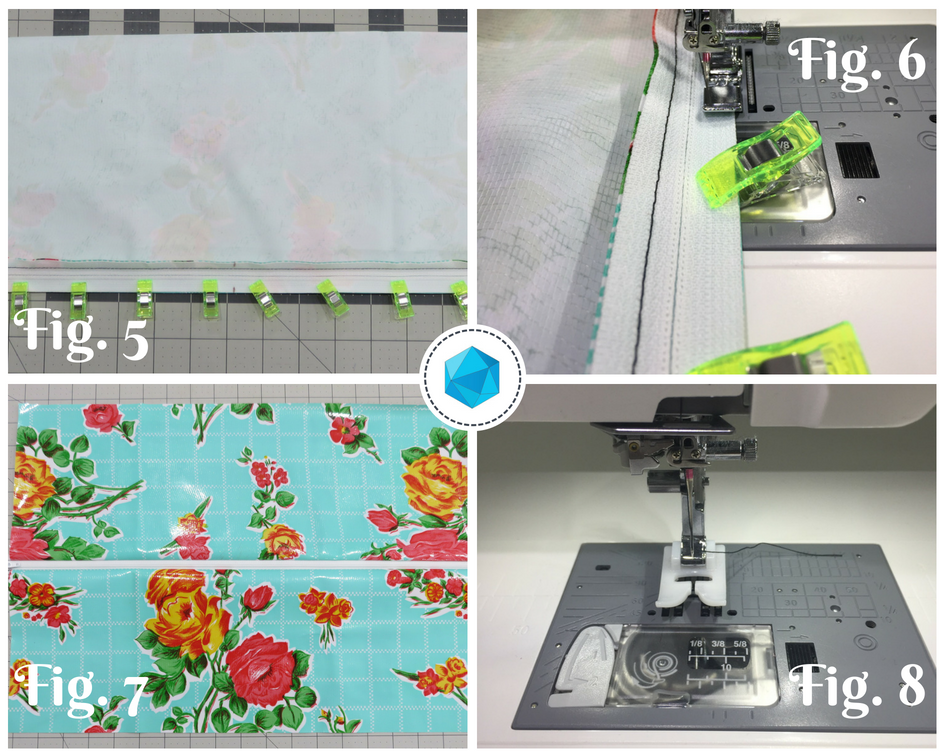
Topstitch 1/8″ away from the folded edge of the oilcloth (see figure 9).
Round the corners and baste the pom pom trim
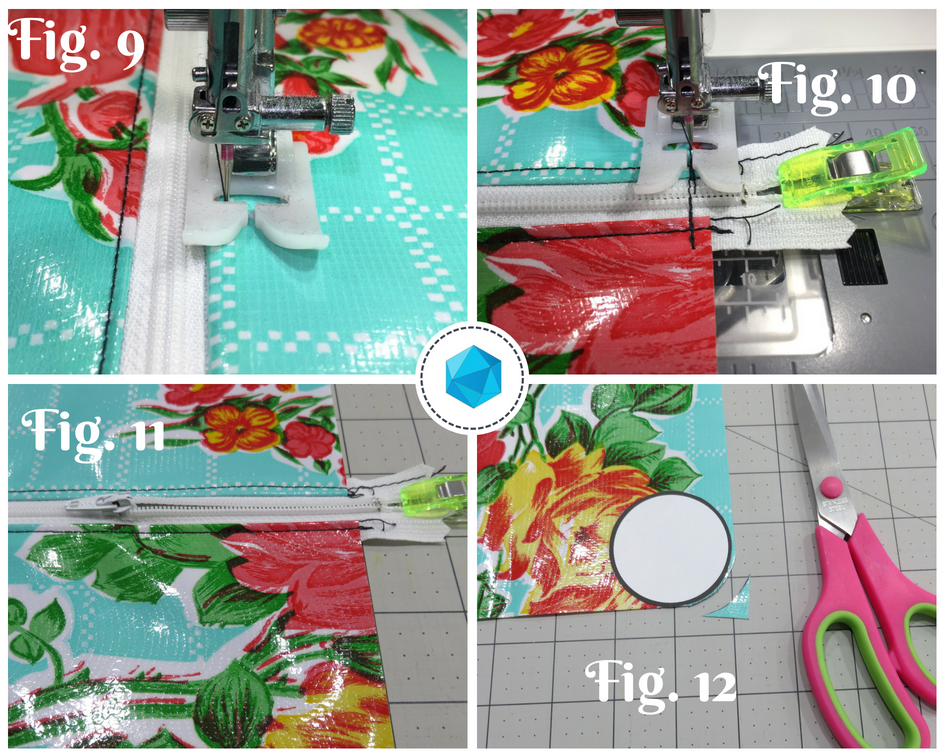
Sew the pillow together and finish
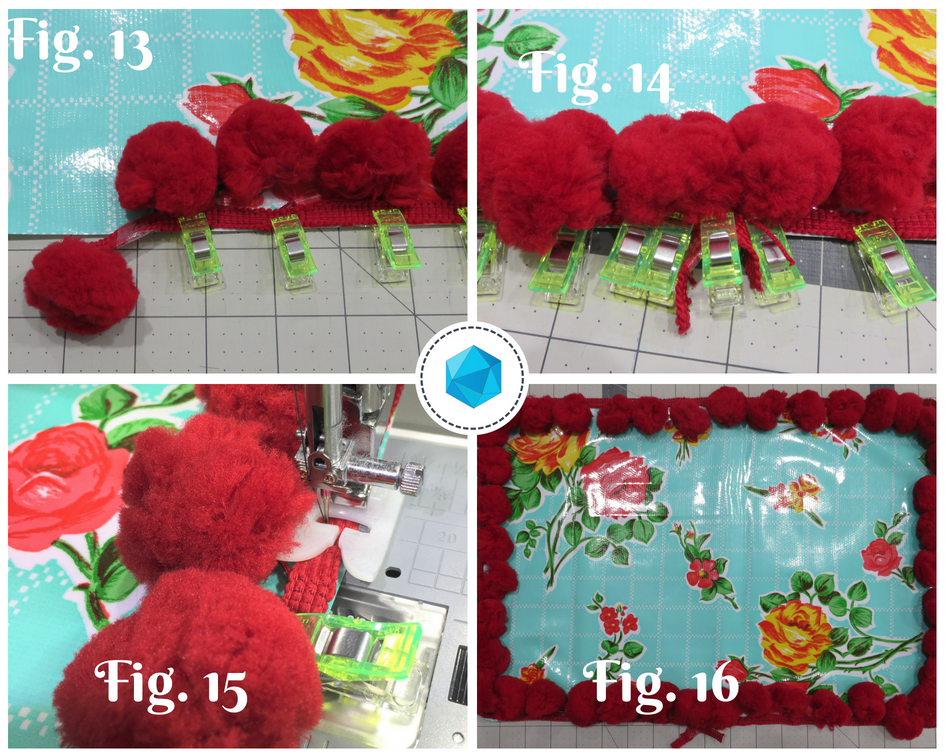

Tip: Oilcloth has little to no stretch, unlike cotton fabrics you might be used to working with. A zipper closure helps to keep seams sewn together versus using an envelope closure. Be careful to not stretch the fabric when inserting the pillow form. For a fully weather-resistant pillow, you can opt to sew this pillow without the ball fringe trim.
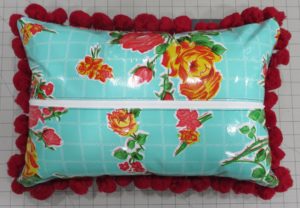
Now get out there and party with your new DIY outdoor pillow 😉
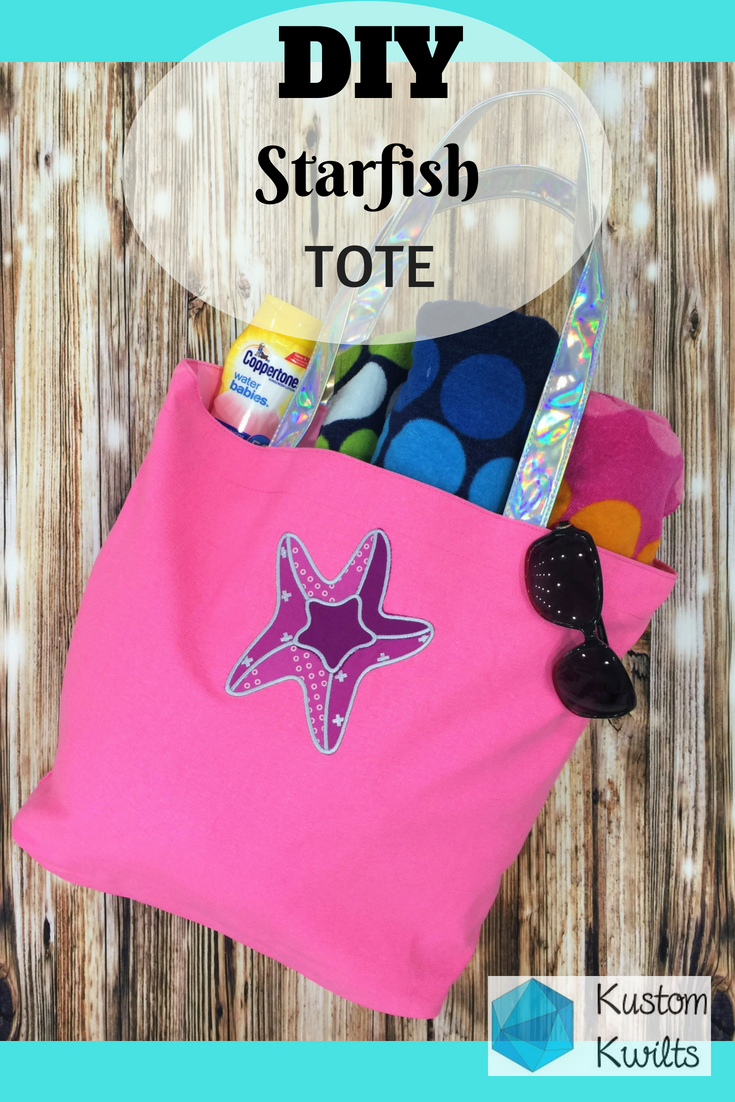
Are you looking for some cute and quick Summer sewing projects? Then you’ve got to hop over to the 2018 Summer Sewing Camp with Janome! The first three weeks of projects are already available, and there’s even a cut file for a camp t-shirt. It’s all the fun and creativity of summer camp without the hefty price tag, so you really can’t go wrong :). Every Monday, through July 30, a new sewing project will be released that can be finished in a couple of hours with minimal supplies. You have to check out the DIY Starfish Tote tutorial!
My contribution was Week 3– A DIY starfish tote bag with the option to use an embroidery design (if you have an embroidery machine) and an option to applique the star with a regular sewing machine. If you want a really quick finish, you can purchase a ready-made tote bag or follow my simple instructions to make your own!
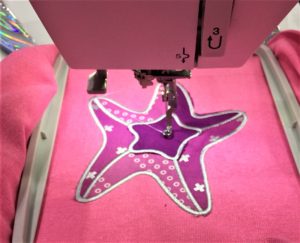
I used an embroidery/applique design from the Janome Embroidery website and it was so quick and easy to do, I was literally done in 30 minutes with the applique! I hope you enjoy this quick and easy FREE tutorial–you can download it from the Janome site linked above, or you can download the DIY Starfish Totehere as well 🙂
This is a great project to do with your kids to combat boredom and then load the bag up with some beach towels, sunscreen, and snacks and head over to your local watering hole. Or if you really want to score some points, gather up some of your kids’ friends and really create the camp feeling! If you participate in any of the projects, be sure to share what you make with the #janomecamp18 to be entered in the giveaway drawing that will end on August 13, 2018. They’re giving away a sewing machine AND some other awesome sewing related items, so you’ll definitely want to get in on this!
Happy sewing friends!

If you’re on the hunt for a sweet project to keep your little super hero busy this summer, pick up some satin and felt and sew up this easy superhero cape and mask. I used the Janome MC9400 to put this project together, and you can find the full tutorial HERE.
This isn’t a difficult project, and you can practice some basic applique skills to put a great finishing touch on it. Personalize this project with your kiddo’s favorite colors to really make this project pop!
This tutorial was made for approximately 3T-5T. The mask will fit larger children as well.
My best friend allowed me to have her precious little girl model this for me, and you can tell she’s ready to take on the world 🙂 Happy sewing!

When summer arrives, I always get the itch to make a quilt. Nevermind the fact that I live in Texas and it is sweltering, to say the least. Also, disregard the fact that I have quilts coming out of my ears…what is that saying…you can’t swing a cat without hitting a quilt? (Surely that isn’t the saying, but I think you catch my drift!) So when I am thinking about making a new quilt…I need to have a reason for it, aside from just being functional to keep you warm. I also love to sew with materials that are a little unexpected. So I teamed up with Janome and American Quilter’s Society to bring you a free tutorial for a great summer picnic quilt.
This pattern is great for many reasons. It’s layer cake friendly, which makes it a super quick sew. The blocks are large enough to feature those great prints you’ve been holding on to for a special quilt. The quilt is large enough to accommodate a family picnic at the park. The backing can be made from laminated cotton (or regular quilting cotton, if you choose), so it won’t pick up dirt as easily as standard quilting cotton. You can just as easily throw it in the wash as you can a regular quilt (line dry to be on the safe side). So grab two layer cake packs and your favorite sewing and quilting notions and get ready to sew your socks off! Follow the link to the American Quilter’s Society blog to get started on your picnic quilt.
This is a great quilt to fold up and keep in the back of the car for unexpected outings (and if you have a little one in diapers, you can always use the laminated cotton side as a quick changing station on the go!).
I quilted this with some large meandering loops on my Janome MC9400, and was done with the quilting in under two hours.
Since the back of my quilt uses laminated cotton, I slipped a Supreme Slider onto the bed of the sewing machine and it really helped glide the fabric easily under the needle. This isn’t something you have to do, but it certainly makes the task a little easier. I tend to use one anytime I’m quilting something larger than a mini quilt. Put on your favorite podcast/Netflix and get ready to sew up a storm! Happy sewing 🙂

 |
| DIY first aid kit |
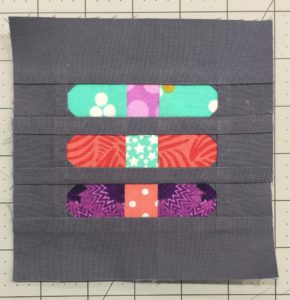 |
| finished foundation block |
If you don’t feel like messing around with the band aid block and the paper piecing, you can totally skip that part and just cut two slid pieces of fabric for the front and back. But those little band aids are so cute!
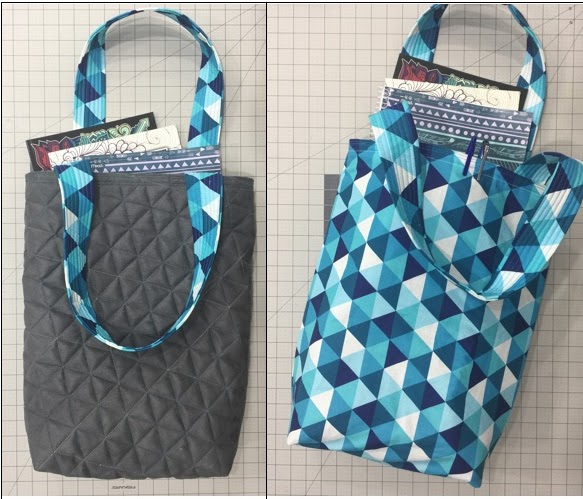
 |
| Reversible Notebook Bag |
Plus…we’ll take a look at quilting on a thicker fabric than your usual quilting cotton. I do a lot of quilting and embroidery on leather and faux leather fabrics, and there is a lot of hesitation when it comes to that from some. When I started sewing, I didn’t take a bunch of classes…rather, I just dove in and experimented to find what worked for me. I didn’t have anyone there to tell me I shouldn’t try something, or that it wouldn’t work, so I think that was a huge benefit. For this tutorial, break out that walking foot (or your free motion foot) and try your hand at some geometric quilting.
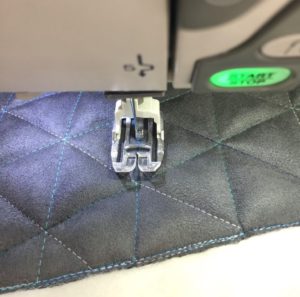 |
| Janome Dual Feed Foot quilting geometric lines on faux leather |
If you haven’t tried quilting on leather or faux leather before, I’d recommend getting a few scraps of some cheap faux leather–my local Joann’s has lots of remnants on clearance that I grab whenever I can–and do some quick samples. I usually do my best work on “trash” fabric when there’s no pressure to mess up expensive fabrics. I’ll make sure my pieces are big enough to make a little cosmetic bag or something with later on, because 9 times out of 10, I end up wishing I could save my sample!
This really is a quick sew–and you can easily alter the bag measurements to make the bag any size you like, upgrade it to add some pockets on the interior and exterior, or whatever your needs are. Check out the full tutorial on the American Quilter’s Society Blog and have fun with it! Go and conquer your fears of quilting on some different fabrics, and happy sewing!

A few weeks ago around Mother’s Day, I was contemplating what handmade gifts would be truly appreciated by mom. As a new mom, I was excited to celebrate my first mother’s day, but didn’t really care about getting any gift (I honestly wanted some house chores done as a gift, and maybe some honey-do’s!), so I was thinking about gifts with meaning. I was seeing lots of advertisements on social media for jewelry and diamonds and just lots of STUFF. I’m not much of a jewelry person, but the diamonds got me thinking about birthstones and some of the jewelry I had seen a few years ago. I remembered one of my friends receiving a ring that had her kids’ birthstones set in it, and how much she loved it. How could you translate that representation into a quilt? And how many people have time to whip up a “quick” quilt, by the time they are pondering mother’s day gifts?
I thought a decorative pillow for the couch or bed might be more practical and manageable on a short time frame. So I teamed up with Janome to create a generational pillow that would be a great design for using the birthstone jewelry idea and making something for the home. You can view the free tutorial on the Janome Projects Website

Good morning! Things have been a whirlwind in the last month! I have some really exciting things that I’ve been working on at Kustom Kwilts & Designs that I can’t wait to share with you in the very near future, and I’m so excited that I can finally share this free tutorial with you that I teamed up with Janome to bring you. Find the full tutorial HERE- at the AQS blog
There are some specific things I look for when creating a handmade gift for someone. I like a quick project that looks like it took a LOOOOOOOOOOOONG time. This is one of those! The supply list is fairly short, so you can easily grab a few fat quarters from your stash and get this project going today, in time for Mother’s Day next week, or whip up several for those really awesome teachers in your child’s life. The tutorial allows for you to select from several sizes of tablets, so you should be able to select the size your person uses and get going right away!
I’ve been sewing on the newest Horizon Memory Craft 9400QCP, and this machine is a true workhorse. I love everything about it, and quilting on this machine has been a lifesaver. It creates absolutely beautiful stitches and really makes my projects look professional.
I hope you’ll take a minute to check out this free pattern–you’ll love the simple style and elegant finish you can achieve with basic or complex quilting. You can really make this your own and put your special touch on it to brighten someone’s day. I hope you enjoy your weekend!
XO,
Joanna